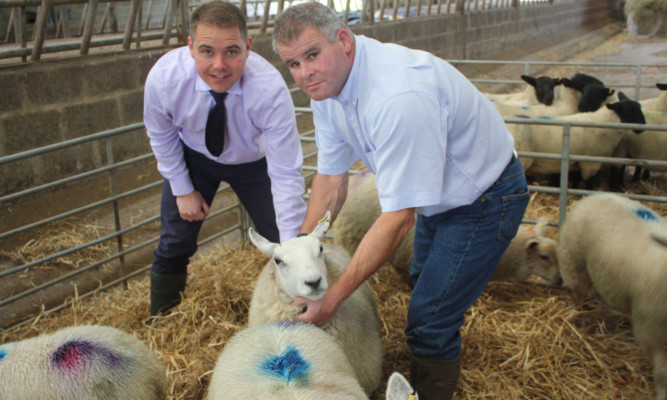Lamb producers looking to lift margins from their flock can make small changes to ensure better returns.
That was the focus of a meeting of the Central Lamb Supply Chain Group held at Parks of Aldie Farm, Fossoway, Kinross, with a follow-on visit to Scotbeef, Bridge of Allan.
Group facilitator Raymond Crerar of SAC Consulting reminded the group of more than 30 attendees that, while they cannot influence price or effect market volatility, with an improved understanding of grazing and post-weaning management they can reduce their costs and receive the best return from their lambs.
Sir David Kinloch, who resides at House of Aldie and owns Parks of Aldie, welcomed the group.
He said the farm extends to 630 acres, mostly down to grass, with 80 acres of spring barley, 16 acres of forage rape and 130 acres of carefully managed woodland.
The operational responsibility lies with farm grieve Alan Sim. Together with farm business adviser Peter Hall of Laurence Gould, the team manages the flock of 930 Scotch Mule ewes.
A key performance indicator (KPI) dashboard had been prepared and shared with the group. The KPIs showed a scanning rate at 195%, tailing at 168% and weaning at 166%.
Daily liveweight gain had also been calculated and to weaning came in at 282g per day. This is within the “very good” category and by the end of last month, 228 lambs were already sold.
Finishing as many lambs as possible off grass is an objective for the Parks of Aldie team and they rely on turning lambs on to good clean pasture at weaning to avoid a growth check.
The group inspected pasture cover and saw for themselves the quality of the grass.
SAC sheep and beef specialist Rhidian Jones said: “Weaned finishing lambs need to be given the best quality grass and clover on the farm to keep growth rates high and enable faster finishing.
“Lambs only growing at 100g per day will take three times longer and consume twice the dry matter of lambs growing at 300g per day.”
Bryan Robb of cooperative buying group Farmstock (Scotland) Ltd handles the Parks of Aldie lambs to fulfil Scotbeef supermarket and export contracts and informed the group of the requirements for this market.
The ideal carcase weight is 16-21kg, so ideally lambs should be no more than 43kg in the liveweight scales.
Regular selection is the best way to meet the specification.
The group was given a demonstration, with Bryan commenting: “To check your lambs have a good finish, use your hand to feel right along the loin on both sides, whilst pushing down to assess the fat cover.
“As the season progresses, the tail, to assess its fat cover, is a good indicator of whether it is ready or not.”
Bryan advises to be on the lookout for such lambs so they can be marketed while they still meet the specification.
With the knowledge they were to inspect the lambs on the hook at Scotbeef, the group were given the opportunity to handle Suffolk, Suffolk/Beltex and Texel/Beltex lambs for themselves to assess conformation and fat cover.
The following day, more than half the group arrived at Scotbeef to discover the lambs had killed out very well, producing mainly U3L carcases with a number of E and some R grades too.
Bill Mackinnon of Scotbeef recapped on the importance of meeting the specification to receive the best prices and highlighted the increasingly important duty of care to present clean stock.
He said: “Lamb cleanliness is the first stage in compliance with the food standard regulations.
“We require all lambs to be free of dung round the tail. In winter their bellies must also be clipped and we encourage farmers to keep the lambs off grass and in a clean straw-bedded shed the night before they are brought to the abattoir.”
Caroline Robinson, veterinary investigation officer at SAC’s Perth Veterinary Centre, advised using clean pasture for weaned lambs.
Low-risk grazing has only small numbers of worm larvae on the grass.
This will include fields that have had no sheep on them for 12 months.
Fields only grazed by cattle or cut for silage this year are also low-risk, as are forage crops or stubble fields.
Aim to avoid lambs carrying an excessive worm burden as infection damages the gut and may reduce feed intakes by 12.5%, resulting in reduced growth rates.
Use faecal worm egg counts to avoid worming unnecessarily.
If a wormer is required, adhere to best dosing practice by weighing the lambs in the batch and dosing to the heaviest, Caroline said.
If moving to clean grass afterwards avoid accelerating resistance to wormers by either leaving the best 10% of the lambs untreated or returning the group to their current field for four or five days before weaning.
Caroline cautioned on the effectiveness of wormers and urged the group to select a wormer carefully.
The best way to know if the product is working is to test it by collecting 10 individual dung samples from lambs and taking a note of the ear tag number of each.
Submit the sample to your vet for a faecal egg count.
Administer the wormer and two weeks later carry out another test on the same group of 10, taking the vet’s advice on timing.
If a wormer is not more than 95% effective in reducing the egg count, some wormer resistance may be developing.
Four more meetings of the supply chain group take place this autumn and winter.
The meetings are funded by QMS, Farm Stock Scotland Ltd and the Scottish Government Skills Development Scheme.
They are facilitated by SAC Consulting and aim to enhance collaboration and communication in the supply chain and improve productivity and profitability at all levels.
